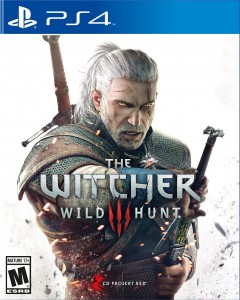 Title: Witcher 3: Wild Hunt
Title: Witcher 3: Wild Hunt
System: PS4 (also on Xbox / PC)
Genre: (A)RPG
Developer: CD Projekt Red
Publisher: CD Projekt Red
Date Played: February / March 2016
Rating: Sprawling and involving
I had such a great time playing Bloodborne earlier in the year that I couldn’t resist another foray into the world of console RPGs — this time the highly regarded Witcher 3: Wild Hunt. And by the way, I’ve never played a Witcher game before, barely even heard of them.
But Witcher 3 has garnered tons of great reviews, sold 6 million copies last year, and has an interesting development history. CD Projekt Red is a Polish company that is relatively new (to making original games) and does its own publishing too.
Which leads me pontificate on Witcher 3 (and to a lesser extent Bloodborne) in the context of the history of video games and of RPGs — of which I have played (more than) my fair share over the last 35+ years. Although both of these 2015 console games are both great, and both technically ARPGs (Action Role Playing Games) they are worlds apart in style and design emphasis. As I discussed before, Bloodborne is essentially descended from Castlevania, with a bit of RPG DNA grafted in. Bloodborne is all about learning how to navigate through very fixed levels of extremely difficult monsters. You memorize where they are, and how to beat each type, and you do so primarily by mastering one of the best hand to hand combat systems yet made. The core of the game is closer to a Brawler (like Final Fight) or Fighting Game than it is to old school RPGs. The RPG element is a way to customize and level up your character.
Witcher 3, however, is a bonafide descendant of the OG RPG family. And while like all good games, it inherits from countless older games, if I were to pick a “most important ancestor” I’d go with Ultima IV: Avatar. Both games focus on questing (in U4’s case, proto-questing as the formal quest hadn’t been as formalized), big worlds, and moral choices. And I mean the greatest compliment to W3 by placing it in this family, for U4 is one of the best RPGs of all time, and W3 is a very modern, very worthy successor.
I have to say, that for a few hours I was a little disappointed with W3, thinking that it just wasn’t as good as Bloodborne (which I’d just finished). It’s certainly slower paced. But the game has really really grown on me. They are very different RPGs and W3 is fantastic in its own right, just with a total different design balance.

Every game design team has to decide what they are interesting in focusing on, and you can assign them buzzwords, but let’s really break this game down by looking at separate elements and how the game emphasizes them.
Setting/Style/Graphics. W3 is set in this mysterious “northern middle ages” of the 1200s. It’s gritty and “real” except there are monsters and magic. The world is vast. Really vast. Fairly sparse, with a lot of riding or running around through the wilds. People eek out a living and it feels pretty authentically medieval. It’s based on a fantasy series by Polish author Andrzej Sapkowski. The moral style of both books and games diverges from the traditional black and white tropes of fantasy to offer an extremely (deliberately) gray scale picture of the world. The hero Geralt is a monster hunter and sword for hire, and he blends worldly cynicism with a certain heroism — but in the game all your choices have consequences (more on that below).
The graphics are realistic and naturalistically gorgeous. Not hyper colorful, nor drab.The world is lovely in a Northern way (bogs, forests, tundra, water, stone). I haven’t seen any desert or jungle. There is weather and time of day and very nice natural lighting. You often get these gorgeous sunsets and the like. The people are naturalistic, ugly even. Textures are very high resolution and there is a LOT of animation — pretty good animation at that — not Naughty Dog great, but very good. The voice acting is spectacular as rule, particularly Geralt — which is a good thing given how much you have to listen to him.
Things are lusty. There is a ton of swearing. There are wenches and strumpets and actual nudity and sex. It’s kinda weird as I’m not that used to this in video games, but also at the same time like a bawdy 80s fantasy novel (which it derives from), and therefore slightly in the Conan school, but much darker.
There is also a ton of detail, particularly in the construction of minor ruins and castles. While built of similar materials, each feels uniquely constructed. Vistas abound, as do lush sunsets, the glare off ice blue water, the bright expanse of a sun spilling in through a castle window. Witcher is a pretty pretty game with a surprisingly un-game-like visual style.
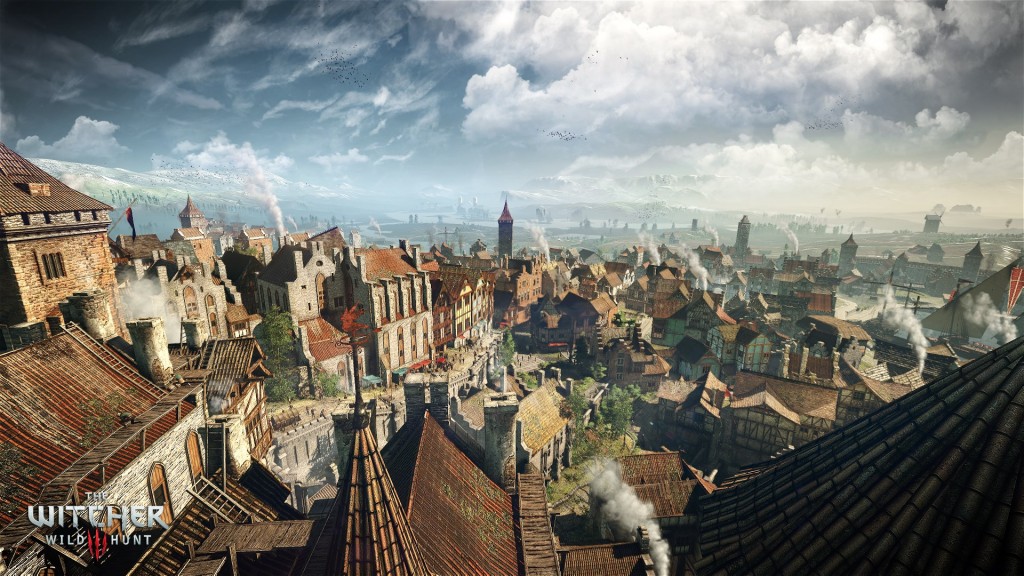
This enormous city is fully explorable
Story. There is a lot of story in W3, both in the past and in the present of the game. Bloodborne by contrast is a game with almost no present story, very little dialog, just a very complicated mood and world and a bunch of events that setup that world. W3 has all sorts of personal and political history, some of it from the previous games, but it also includes a monstrous (haha) number of hours of directly related, animated, voiced over story. Online I read that there are 300 hours of recorded dialog! This includes an enormous main story with very elaborate central quests and plenty of options as well as an epic number of side quests. Plus Geralt helpfully comments on things constantly.

Geralt’s two main squeezes, Triss and Yennifer
Questing / Gameplay. Like many RPGs before it, W3 aims for a a quest driven gameplay. It’s not a grind driven game, in fact monster XP is poor enough and monsters sparse enough that you’d be ill advised to go out just for the purpose of killing. It’s viable to explore “unknown markers” (question marks on the map) and discover/kill whatever is there, but these aren’t super dense either. Mostly, you work through the quests which will drag you into the game’s three main mechanics anyway: travel, investigation, and combat.
But let us compare the sub-balance with World of Warcraft. In that game, a quest giver will deliver a couple written paragraphs of mumbo jumbo, which you won’t read, which will basically sum up to “kill 14 boars in this zone” or “collect 7 blood crystals” which are either dropped or guarded by said boars. Mostly in WOW, you collect 3-4 quests that allow you to kill monsters in the same area repeatedly until you have finished off those quests. I rarely read much of the quest text, even though my main has the Loremaster achievement (having finished EVERY quest in the game!).
In W3, however, ALL the quest dialog is animated and blessed with voice over. This alone ups the interest level by a factor of 10 and is an impressive feat. Plus, the quest writing is far more character driven and the goals usually less about grinding some monsters. Most quests involve numerous steps before the kill, usually an investigation and some more dialog. This dialog usually offer Geralt choices, and the designers have cleverly set it up such that the quest usually finishes no matter how you chose, yet the consequences vary. In countless scenarios, someone must live and someone must die — and it’s usually Geralt who chooses, although not always with clear insight as to the ramifications of the choice. Do you want to get out of an argument by using the force, bribery, or violence? Well, you’ll get to chose (a lot). So not only did CD Projekt Red have to write the quests, then record, animate, and program them, they had to write them with branching options and multiple endings. This goes for both main and side quests too.
Now, there is some clever structuring here where the choices more or less fold back together, or in the case of side quests the varied consequences don’t matter to the main story. For example, you might be thrown into prison and can escape by stealth, combat, money or magic, but anywhichway you will end up at trial. Or you might have a choice to let a malfeasant go (and maybe get a reward) or kill them and collect the loot. Occasionally, these people you save will show up again later (or not) and your choices will have big long term consequences.
This is particularly the case with the “romances.” Geralt is a lusty fellow and he has two main love interests in the game, along with a couple (possible) side affairs and a whole bunch of “strumpets.” With the two main ones, how you play influences who you end up with, and it’s all a little hard to predict. I ended up consulting with the internet to try and divine the “best” choices — but the game is structured to elude any optimal solution. If you try to romance both hard, you end up with neither.

Sometimes the feel is decidedly Eastern European fairy tale
Mechanics. if the questing is the mid level gameplay, the mechanics are the actual controls and combat. W3 has spread the love in terms of designer effort, and the lower level mechanics are good but not perfect. Combat has a variety of options and there is a nice skill tree. You can balance between melee and “signs” (simple combat magic). Brewing up potions is significant. The actual fighting is fun, and blessedly single character action based. One of the things that has scared me away from some recent well-reviewed console RPGs like Dragon Age: Inquisition is the party based combat. I never find it fun. Witcher‘s solo fighting is great. However, this is no Bloodborne, where a huge percentage of the design effort was spent on the intricate physical combat and the myriad weapons. In Witcher, all the weapons feel more or less the same and the game doesn’t “real your mind” with regard to the nuance of strikes, but it’s still satisfying head loping fun. Witcher‘s combat is also vastly easier than Bloodborne‘s nail biting encounters and bosses are just larger typical monsters, not highly specialized (and brutal) special encounters.
Geralt’s normal non-combat control also isn’t as stellar as Bloodborne‘s. He has a bit too much inertia and there is something a little funny going on with the rotation of the camera such that I constantly got turned around for a second — even after 50+ hours of play. In BB, the control is dead on, earning them an A+. Witcher‘s are more in B territory. They are good enough, and the overall game great enough (it really is a superlative overall game), that it’s not a problem — but they could have been better.
An interesting and new (to me) sub mechanic is Geralt’s skill at investigation. He has these Witcher Senses, which a bit like the sonar mode in The Last of Us allows you to slow down and see the important things in the world. But the Witcher uses this like no game I’ve played before. You can use it to look for look or monsters, but you also use it constantly to find secret passages, hidden traps, foot prints, blood stains, and to generally follow and track villains to their lairs. I have to say it’s a very effective mechanic, and very much in keeping with the exploratory pace of the game.
Also like The Last of Us, there’s a significant looting “minigame.” In that, there are chests, barrels, and bags of stuff EVERYWHERE and you can spend as much or as little time as you like scavenging from them — albeit with care, as sometimes guards take offense. Oddly, peasants don’t, so you can pilfer their houses right under their noses. I found lots of good stuff this way, and as crafting and alchemy require tons of materials and are very valuable in this game, I played as quite the petty larcenist.
Between Geralt’s various modes and gear, inventory management, the map, quest management, etc. there is a lot of menu use. And the menus can be a bit clunky, particularly getting in and out of shop keeps. The inventory has sluggish tabs and there is this strange need to page through them all to reach the shop keep’s “tab.” Then, if you want to actually equip an item you might have to back out of the whole store and go into the normal inventory. But at the same time, the game’s need to “keep it real” wth the dialog means Geralt will have to pound through “hey, how are you” “can I take a look at your goods” and “farewell, maybe I’ll be back later” types of useless animated dialog — again and again. Some of these asset and menu controls are more like C+ or B-. They don’t ruin the game, but they could use some programmer/designer love.
There are a couple additional side mechanics in Witcher 3. A major one is the Gwent card game. This is a Hearthstone/MTG style minigame available across the whole world. I found the pace too slow and after a couple (loosing) games just skipped it as best as I could. Some people might enjoy it, but I was more focused on the the main game. Sometimes there is also horse (or foot) racing too. This was closer to the main mechanics and I enjoyed it much more. Sure, it was sometimes hard to know where the race course was and accidentally straying led to frustrating losses, but for the most part it was fun.
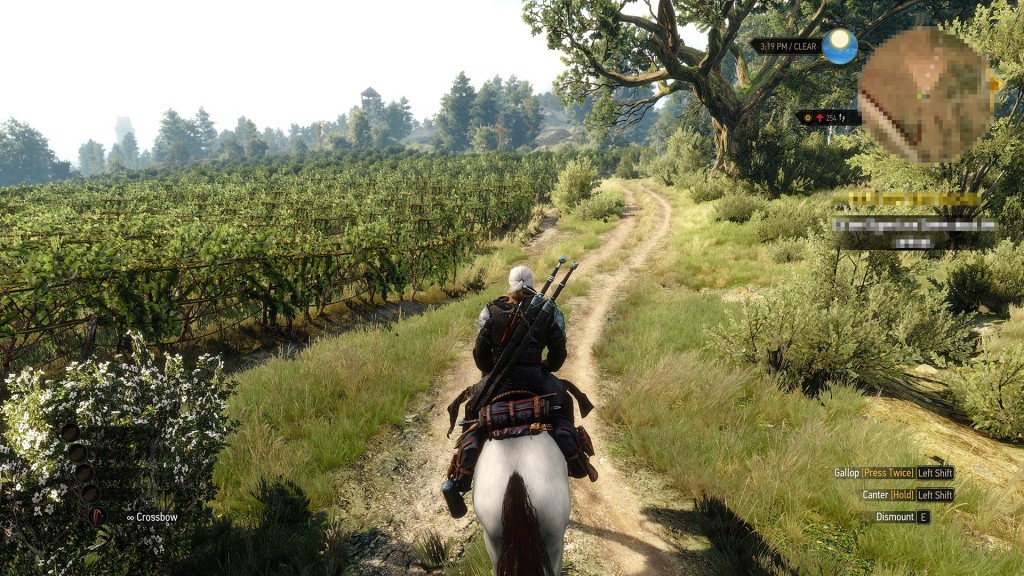
You spend a lot of time on your horse Roach
Meta-Game/Progression. I’ve played hundreds of RPGs and Witcher has an unusual balance. Leveling is glacial. It’s several hours (maybe 2-4?) between levels and the amount of XP both needed and earned is fairly flat. 60+ hours in and I’m still at level 22. This isn’t like WOW‘s carefully orchestrated progression where early levels ding in quick secession and new abilities are dolled out one by one with ordered and rapid progression. In the Witcher, you have all your spells at the start. Sure you can improve and modify them with the ability points (slowly), but it’s mostly there to begin with. There is no choice of complicated rotations and the like inherent in each build (ala WOW or Diablo 3). Builds are more about emphasis. There is a lot of gear, but the Witcher sets, found through following specific treasure quests, are the best. Questing and exploration are more emphasized in this game than gear and character progression.
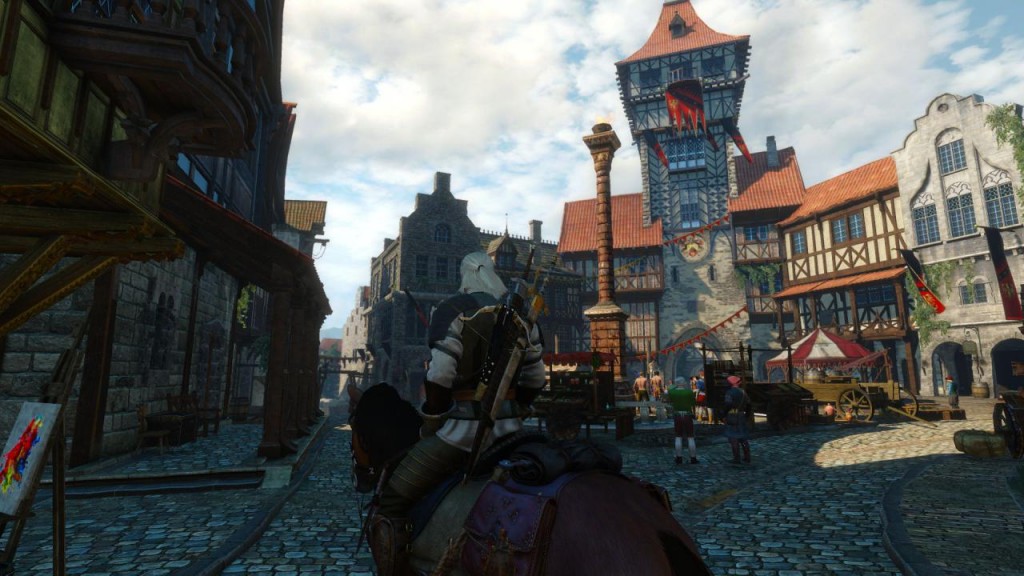
Medieval Europe brought to life
Odds and Ends. PS4 load times are pretty abysmal, particularly when you die. Think at least 1-2 minutes on the load screen. This is a big detailed world, and the blu ray isn’t the speediest, so I half understand. But it’s possible to zone in, move 5 feet, die, and still spend over a minute loading. The programmers must dump all of memory and start over. I solved that problem in the mid 90s :-). Fortunately you don’t die that often, but teleporting across the world and back to turn in a quest or sell loot can be annoying. As is the “weight limit” mechanic. This is one of those “some RPGs do it” things, and I never love it. When you are full you even walk slow and can’t use fast travel! Another complaint is summoning and mounting Roach, your trusty steed. For some reason, he’s a bit shy, and he has a knack for always showing up behind you. Then when you mount up the camera somehow rolls around leading to an inevitable canter off in the wrong direction.
It’s also worth mentioning, that while Geralt is a bad ass capable of slaying the most fearsome of monsters, he must have fragile bones because a fall off the wrong roof or cliff edge can easily lead to instant death. Save often in the presence of these perilous foes.

The views are frequently just awesome
Balance. It took me a few hours to adjust to Witcher‘s peculiar game balance. This isn’t a super fast paced game, but once you accept the beauty of it, and the incredible depth of its gorgeous, windswept, Nordic game world and complex moral/character driven plotting, this game really grows on you. Sure, if I were the producer I would have spent another month or so tuning up the inventory and control mechanics. But the game’s greatness transcends a bit of control clunk. And I have the impression Witcher 3 represents quite an improvement in this regard over the earlier installments. If the story / exploration aspects of fantasy RPGs appeal to you at all, than Witcher is a MUST PLAY, having created one hell of a real-seeming world.
NOTE: As of 3/13/16 I’ve completed about 75% of the game. More thoughts to come after I progress…
For more video game posts, click here.
| If you liked this post, follow me at:
My novels: The Darkening Dream and Untimed |
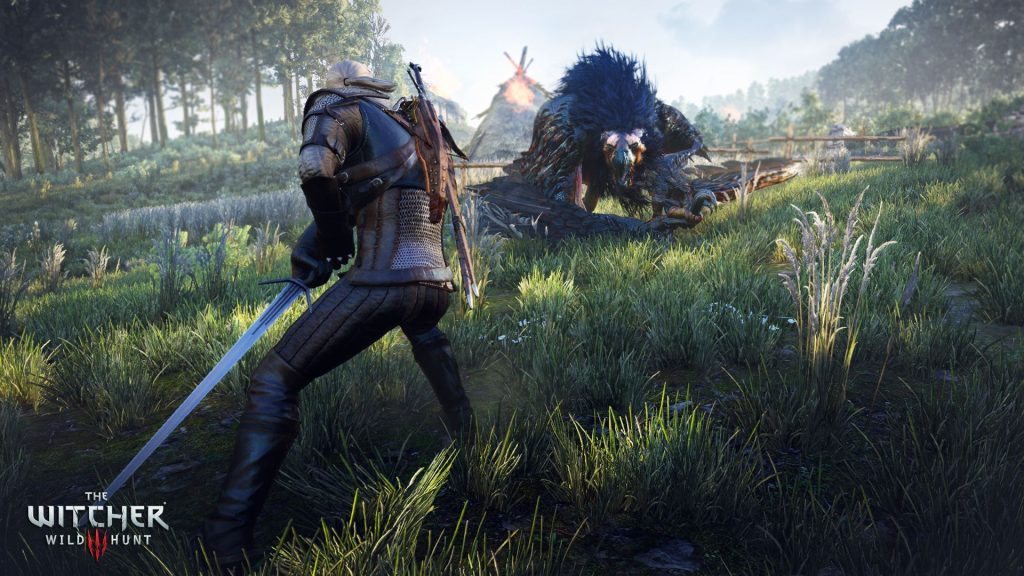
Lots of classic monsters



